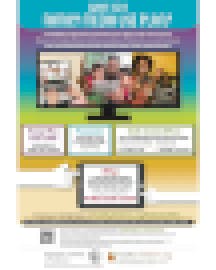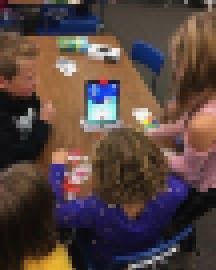Admittedly, as an educator I’ve popped my students in front of a movie in moments of chaos, and as a parent, I’ve found myself leaning on the not-so-educational show to calm my toddler during the witching hour. I know what screen time can look like when it is not optimized for learning. But over the past two years, as our district has rolled out our 1:1 device initiative to an increasing number of grade levels, I have also witnessed the benefits that some types of screen time can have on learners.
Most of my colleagues agree that not all screen time is created equal—but with all of the hype in media and the gray area that leaves some screen time recommendations open to interpretation—convincing families has been harder than we anticipated.
In the past, screen time has been linked to obesity, depression and lack of social skills. Fears around too much screen time are deeply rooted in published research studies, news coverage and blanket bans and limitations set forth by the American Academy of Pediatrics (AAP) and summarized by institutions like the Center for Disease Control (CDC) and Common Sense Media.
The AAP’s guidelines from 2002 stated that there should be no media use for children under the age of two, that 2- to 5-year olds should be extremely limited in media consumption and that children over five should consume no more than two hours of media per day. Even though the AAP updated its screen time recommendations in 2016, organizations have developed tools and resources to support healthy screen time habits and the media has taken a more balanced approach to covering screen time, fears remain.
For too many years, the AAP, CDC, and the news media failed to differentiate between screen time for entertainment and screen time for learning. This lack of clarification for over a decade has left many parents with anxiety about device use in general (and rightfully so!)

This has put pressure on schools and districts to carefully explain and prove why adoption of digital tools is not only beneficial, but necessary. As our district has rolled out 1:1 devices to middle and high schoolers over the years, we have heard concerns from families like: “This much screen time can’t be good,” and “What about brain development?” When it comes to the right amount and type of screen time, there seem to be more questions than answers—and often, parents are lumping together questions about recreational screen time with technology for learning.

The increased flexibility of the AAP’s updated guidelines have been helpful. While previous recommendations encouraged parents to limit all screen time to no more than two hours per day, the updated guidelines are more more vague, leaving space for interpretation, particularly for grade-schoolers and teens. Parents of school-aged children are now encouraged to create a balanced family media plan to help guide what feels right for their family and it’s needs; there’s even an online calculator to help.

However, these new guidelines haven’t negated the fears set forth by the previous limitations. Our district has had to work harder than we expected to get parent buy-in for our 1:1 initiative. We’ve needed to educate families about how various organizations and institutions like the AAP, CDC and Common Sense Media define the term “screen time,” and how these definitions impact interpretation of the the recommendations they provide.
The umbrella term has been used to describe everything from TV programs to video games, social media to podcasts. The APA defines screen time as “time spent using digital media for entertainment purposes” and the recent distinction between entertainment and learning has been helpful because it can guide conversations around what kinds of screen time should be limited. And yet, even with the clarification of recent years to specify screen time as entertainment media, parents are still anxious about handing their children a device.
To convince families that we, too have their child’s best interests at heart, we've had to clarify what we plan on doing with each digital tool we introduce to the classroom, and how it will serve to enhance the learning environment. What we hope to convey to our families is that while the tools we will be using will have an element of screen time, they are digital enhancements of the work students are already doing.
As we plan for the next phase of our roll out of district-managed devices for all students in grades 3-5 over the next year and a half, we know we’ll be hit with a lot of questions, particularly because the recommendation for children over six years old are somewhat vague: “place consistent limits on the time spent using media, and the types of media, and make sure media does not take the place of adequate sleep, physical activity and other behaviors essential to health.”
We’re prepared to reiterate to families the most recent guidelines regarding screen time use and to encourage the balanced, healthy approach to screen time that the AAP, CDC and Common Sense Media advocate for, including 60 minutes of activity, sleep, family time and time away from screens. Specifically, we’ll be using the categories identified by the Common Sense Census: Media Use by Tweens and Teens to guide our conversations and categorize the kinds of tools we’ll be using.

Communicating Our Goals to Parents
Our goal in communicating with parents will be to highlight the distinction between digital device use for entertainment versus learning. Watching a show on Netflix or downloading the latest pop album to listen to would fall under “entertainment” or “recreational” screen time, while listening to a podcast on a famous historical figure, viewing a video through an LMS, or an app like EdPuzzle, and responding throughout the video to prompts or questions would fall under educational device use.
We also want to help families understand that we have some specific goals that drive our initiative and we are constantly thinking about how to use our devices to reach these goals. Here are four examples we share with families.
Tailor Every Student’s Learning Experience
Newsela is helping our teachers provide all learners with access to appropriate texts. With every text differentiated at a variety of levels, each individual student in a group can read the level that works best for them, but participate in a shared conversation.
More Tactile Learning

Tangible manipulatives are crucial for development of fine motor skills, critical thinking and engagement. Our teachers are taking advantage of the evolving market of tangible and tactile learning tools that integrate with a device via bluetooth (Sphero), the screen itself (Ozobot) or a clever combination of tangible tiles and a reflective adapter (Osmo).
Individualize Assignments and Feedback for Each Student
Educators are using Google Classroom in a number of ways, including meeting our goal to provide unique, targeted feedback on each student’s work and to support students in offering feedback to each other.
Improve Collaboration and Communication

Video chatting and Seesaw enable students to expand their educational community and share their work with a broader audience. Student can now video chat with an expert or share their latest piece of writing with family member or friend thousands of miles away.
Our hope is to educate parents so they can understand that not all screen time is created equal. Sometimes screens entertain, sometimes they distract and in many cases they can support a lot of the skills and characteristics we’ve always known to be critical to growth and development.
As a district, we will follow the AAP’s latest recommendations, creating a balanced mix of learning experiences using both digital and non-digital tools, and we’ll encourage families to do the same at home. Our devices will be used to create, collaborate and communicate digitally, and will provide our students with learning experiences that may not have been possible before. We owe it to our students to not let fears around outdated recommendations and assumptions hold us back. Their futures are counting on it.


